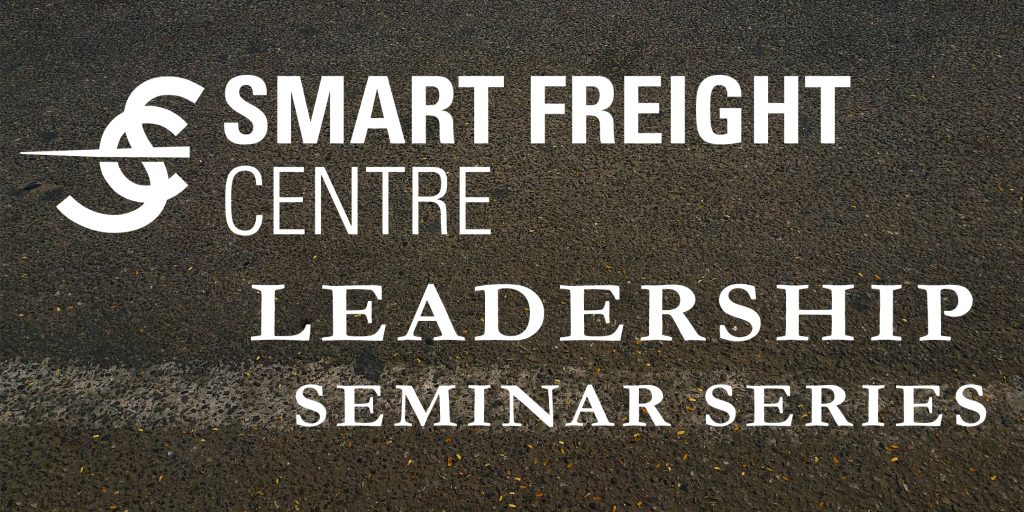Dr. Alison Conway of the City College of New York presented “Freight and Complete Streets: Moving Goods in Shared Urban Space” on November 6, 2020. The presentation was the inaugural event of the Smart Freight Centre Leadership Seminar Series.
UTTRI associated faculty Professor Matthew Roorda, Chair of the Smart Freight Centre, introduced the session and moderated the Q & A following the presentation.
Dr. Conway explored the guidebook she developed with her team to make streets “freight friendly” in urban environments.
Complete Streets means that streets are for everyone, such that they are designed and operated to enable a safe environment for users of all ages and abilities. However, freight has been considered a problem to be solved because of the increased risk to motorists, noise, pollution, and traffic congestion. Despite this, goods have to move in and out of liveable cities via large-scale methods like freight, and Complete Streets need to consider freight operations.
To accomplish this, Conway considered designing streets to support everyday activities in an urban environment, while preventing and mitigating negative impacts of freight through her guidebook “Complete Streets Considerations for Freight and Emergency Vehicle Operations.” The guidebook surveys ten U.S. cities across different urban contexts with input from freight and street design experts. Chapters in the book include fundamentals of freight, fundamentals of emergency services, street design and management considerations, and demand management strategies.
Conway detailed seven common challenges falling under vehicle navigation and curbside considerations in the section “Street Design and Management Considerations:”
- Selecting appropriate design and control vehicle
- Providing adequate space for large vehicle turns
- Reducing the frequency and severity of conflicts between large vehicles and vulnerable roadway users
- Reducing speeds without unintended detrimental impacts on operations and safety
- Providing network connectivity and redundancies
- Providing space for vehicle parking and loading, delivery or emergency operations
- Providing safe access to sidewalks, buildings, and fire hydrants
Solutions to these challenges can take many forms:
- Regulatory: fixed and time-based vehicle size restrictions
- Design: recused stop lines, intentionally allowing some sidewalks to be crossed over, clear identification of conflict zones
- Vehicle based solutions: adding mirrors, cameras, implementing direct vision standards during vehicle design to limit blind spots
- Operational solutions: dedicated signal phases, roadside mirrors, building delivery management systems
- View Alison Conway’s presentation slides for “Freight and Complete Streets: Moving Goods in Shared Urban Space” (PDF)
- Watch the videorecording of Dr. Conway’s presentation “Freight and Complete Streets: Moving Goods in Shared Urban Space” on YouTube
Abstract
Often, freight operations are overlooked or explicitly de-prioritized in the early stages of Complete Streets planning and development.
When freight vehicle navigation and curbside operations are not properly accounted for, implementation of street design changes may result in counterproductive traffic and environmental effects, dangerous and unexpected conflicts – particularly with non-motorized travelers, project delays, and even expensive redesigns.
Recognizing a need for better understanding of freight activity at the planning and design stages of Complete Streets projects, researchers in the City College of New York’s Grove School of Engineering and Spitzer School of Architecture in collaboration with the New York City Department of Transportation aimed to develop a comprehensive guidebook that provides (1) an introduction to freight operations on Complete Streets and (2) a detailed summary of proactive strategies to enable safe and efficient goods movement on shared streets while minimizing negative externalities.
Results from a survey of 10 medium to very large sized US cities identified seven common challenges which can generally be classified into three categories: developing appropriate design criteria; designing streets for commercial vehicle navigation; and providing adequate access for delivery and pickup activity at the curbside and off-street.
This presentation will discuss the specific challenges identified, as well as the design, operational, regulatory, and demand-management approaches implemented in cities around the world to address these issues.
About the speaker
Alison Conway is a Herbert G. Kayser Associate Professor of Civil Engineering at the City College of New York. She is also a member of the research team for MetroFreight, a Volvo Research and Education Foundations Center of Excellence in Urban Freight.
At CCNY, Dr. Conway teaches courses is transportation planning, transportation systems engineering, urban freight and city logistics, and urban street design, and she conducts research primarily in the areas of urban freight and city logistics, freight data, and multi-modal interactions in the urban environment.
Dr. Conway currently serves as Chair of the Transportation Research Board’s (TRB’s) Freight Data Committee, Chair of the ASCE Transportation and Development Institute’s (T&DI) Freight and Logistics Committee, and as a member of TRB’s Urban Freight Committee. She is also a member of the New York City Department of Transportation’s Freight Advisory Committee and of the American Transportation Research Institute’s Research Advisory Committee.


